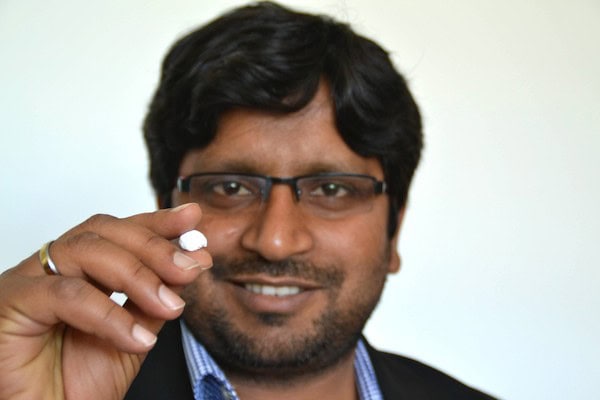
[Image above] Lead researcher Yogendra Kumar Mishra presents a stretchable ceramic made from tin oxide. Credit: Claudia Eulitz; CAU
There seems to be a trend in materials with unexpected properties—glass that doesn’t scratch, smudge, or shine; ceramics that bend but not break.
Researchers at Kiel University (Kiel, Germany) are continuing the trend—they have fabricated a new breed of flexible ceramics by synthesizing interconnected 3-D networks of 1-D nanostructures of tin oxide.
Metal oxides are traditionally brittle materials, but they become surprisingly flexible when stripped down to a single layer of atoms.
However, despite the unique properties and functional promise of 1-D materials—a result of their high surface area to volume ratio—they remain a challenge to integrate into real-world applications and devices.
The Kiel researchers’ technique bypasses those challenges by integrating the 1-D materials into 3-D networks. The resultant product retains most of the 1-D materials’ unique properties, but in a much more stable and integrable package.

Just like wool made of fettucine: stretchable ceramic made from tin oxide. Credit: Claudia Eulitz; CAU

SnO2 nanostructures in a penny-sized package. Credit: Rainer Adelung
“The fascinating part is the structure of the single belt-like nanostructures delivered by this synthesis on the basis of tin oxide crystal structure,” professor Rainer Adelung says in a Kiel press release. “In contrast to ceramic produced with zinc oxide, which leads to very short tetrapod structures, tin oxide gives long, flat structures. They are just like fettucine.”
“And these long flat noodles grow together in a very specific way: In the oven used for the synthesis, temperatures stay just below the melting point of tin oxide. Thus, the noodles find specific interconnection points by kinetics instead of thermodynamics. Each junction is forced into a well-defined angle following strict geometric principles, which are based on so-called twinning defects, as further confirmed by simulation studies,” adds professor Lorenz Kienle in the release.

TEM shows pasta-like SnO2 structures vibrating under the electron beam of the electron microscope. Credit: Mishra; Wiley-VCH

TEM shows interpenetration point of two crossing SnO2 structures in defined crystallographic directions. Credit: Mishra; Wiley-VCH
The uniquely flexible materials could have a lot of interesting new possibilities, such as heat shields, filters, and medical devices, among many more.
“The 3-D networks from tin oxide exhibit interesting features, such as electrically conducting, high-temperature stable, very soft and stretchable architecture, and could thus be interesting for several technological applications”, says lead author and Kiel professor Yogendra Kumar Mishra. “Until now, we have tested sensing applications. Further potential applications could also be flexible and stretchable electronic devices, luminescent actuators, batteries, smart cloths or sacrificial templates for the growth of new materials.”
The paper, published in Advanced Electronic Materials, is “Three-dimensional SnO2 nanowire networks for multifunctional applications: From high-temperature stretchable ceramics to ultraresponsive sensors” (DOI: 10.1002/aelm.201500081).

The Kiel University team, from left: Lorenz Kienle, Rainer Adelung, and Yogendra Mishra in front of the furnace used for the flame transport synthesis. Credit: Claudia Eulitz; CAU
Author
April Gocha
CTT Categories
- Material Innovations
- Nanomaterials


